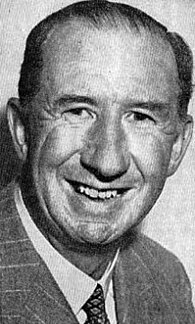
Nevil Shute Norway was an English novelist and aeronautical engineer who spent his later years in Australia. He used his full name in his engineering career and Nevil Shute as his pen name, in order to protect his engineering career from inferences by his employers (Vickers) or from fellow engineers that he was '"not a serious person" or from potentially adverse publicity in connection with his novels, which included On the Beach and A Town Like Alice.

The Hedgehog was a forward-throwing anti-submarine weapon that was used primarily during the Second World War. The device, which was developed by the Royal Navy, fired up to 24 spigot mortars ahead of a ship when attacking a U-boat. It was deployed on convoy escort warships such as destroyers and corvettes to supplement the depth charges.

Brean Down Fort was a Victorian naval fortification designed to protect the Bristol Channel. It was built 60 feet (18 m) above sea level on the headland at Brean Down, 9 miles (14 km) south of Weston-super-Mare, Somerset, England.
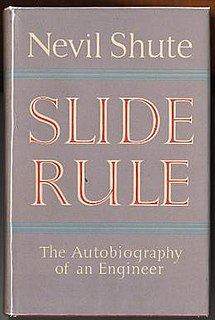
Slide Rule: Autobiography of an Engineer is the partial autobiography of the British novelist Nevil Shute. It was first published in 1954. Slide Rule concentrates on Nevil Shute's work in aviation, ending in 1938 when he left the industry.
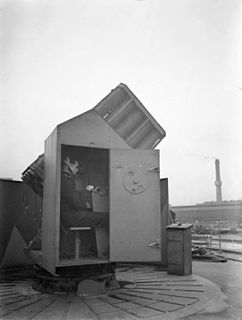
The Unrotated Projectile (UP) was a British anti-aircraft and ground-bombardment rocket of the Second World War. A 7-inch version was developed for the Royal Navy by Alwyn Crow of the Projectile Development Establishment of the Ministry of Supply at Fort Halstead. It proved unreliable and ineffective and was withdrawn from use in 1941. Development of the concept led to the UP-2 and UP-3, which had diameters of 2-inch and 3-inch respectively but were longer. The latter was used as the basis of the Z Battery anti-aircraft weapons and later developed in air-to-ground form as the RP-3, used against ground forces and shipping by aircraft like the Hawker Typhoon and the Bristol Beaufighter. In 1944–1945 several adaptations for general bombardment were produced, including Sea Mattress, Land Mattress, LILO and Tulip.
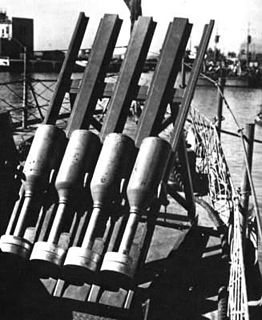
Mousetrap was an anti-submarine rocket used mainly during World War II by the United States Navy and Coast Guard. Its development began in 1941 as a replacement for Hedgehog, a British-made projector, which was the first forward-throwing ASW weapon. Those, however, were spigot-launched, placing considerable strain on the launching vessel's deck, whereas Mousetrap was rocket-propelled. As a result, Mousetrap's four or eight rails for 7.2-inch (183 mm) rockets saved weight and were easier to install.
Sir Charles Frederick Goodeve was a Canadian chemist and pioneer in operations research. During World War II, he was instrumental in developing the "hedgehog" antisubmarine warfare weapon and the degaussing method for protecting ships from naval mines.

Panjandrum, also known as The Great Panjandrum, was a massive, rocket-propelled, explosive-laden cart designed by the British military during World War II. It was one of a number of highly experimental projects, including Hajile and the Hedgehog, that were developed by the Admiralty's Directorate of Miscellaneous Weapons Development (DMWD) in the final years of the war. The Panjandrum was never used in battle.
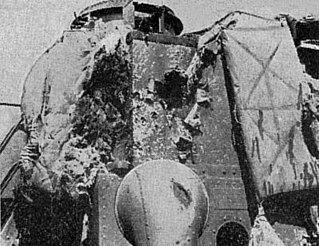
Plastic armour was a type of vehicle armour originally developed for merchant ships by Edward Terrell of the British Admiralty in 1940. It consisted of small, evenly sized aggregate in a matrix of bitumen, similar to asphalt concrete. It was typically applied as a casting in situ in a layer about 2 in (51 mm) thick on to existing ship structures made from 1⁄4 in-thick (6.4 mm) mild steel or formed in equally thick sections on a 1⁄2 in-thick (13 mm) steel plate for mounting as gun shields and the like. Plastic armour replaced the use of concrete slabs, which although expected to provide protection, were prone to cracking and breaking up when struck by armour-piercing bullets. Plastic armour was effective because the very hard particles would deflect bullets, which would then lodge between the plastic armour and the steel backing plate. Plastic armour could be applied by pouring it into a cavity formed by the steel backing plate and a temporary wooden form. Production of the armour was by road construction firms and was carried out in a similar way to the production of road coverings, the organization of the armouring being carried out by naval officers in key ports.

A Z Battery was a short range anti-aircraft weapon system, launching 3 in (76 mm) diameter rockets from ground-based single and multiple launchers, for the air defence of Great Britain in the Second World War. The rocket motors were later adapted with a new warhead for air-to-ground use as the RP-3.
Edward Terrell OBE (1902–1979) was a British Liberal politician, a successful barrister and magistrate with a flair for invention; by 1940 he had registered a number of patents relating to pens, ink bottles and peeling knives. When war came, he volunteered for the Royal Navy Volunteer Reserve (RNVR) and was commissioned as a lieutenant in the Special Branch of the Volunteer Reserve to run an information section.

Diffused lighting camouflage was a form of active camouflage using counter-illumination to enable a ship to match its background, the night sky, that was tested by the Royal Canadian Navy on corvettes during World War II. The principle was discovered by a Canadian professor, Edmund Godfrey Burr, in 1940. It attracted interest because it could help to hide ships from submarines in the Battle of the Atlantic, and the research project began early in 1941. The Royal Navy and the US Navy carried out further equipment development and trials between 1941 and 1943.

The Admiralty Naval Staff was the former senior command, operational planning, policy and strategy department within the British Admiralty. It was established in 1917 and existed until 1964 when the department of the Admiralty was abolished. It was replaced by the Ministry of Defence as part of the Ministry of Defence Navy Department.

The Anti-Submarine Division its original name, was the former anti-submarine warfare, planning and prevention Directorate of the Admiralty Department from 1912-1963.

The Air Division originally known as the Air Section and later known as the Naval Air Division was first established in 1924 and it was a Directorate of the Admiralty Naval Staff, that was initially responsible for operational control of aircraft supplied to the Royal Navy by the Air Ministry. In 1939 it was gained full control for the all matters relating to administration, control, policy and organisation of the Fleet Air Arm, it underwent various name changes until it was absorbed as part of the merger of the Admiralty into the new Ministry of Defence in April 1964 as part of the Navy Department where it continued until May 1966 when its remit was changed and when became the Directorate of Naval Warfare.

The Admiralty Signal and Radar Establishment (ASRE) originally known as the Experimental Department and later known as the Admiralty Signal Establishment (ASE) was a research organisation of the British Royal Navy established in 1917. It existed until 1959 when it was merged with the Admiralty Gunnery Establishment to form the Admiralty Surface Weapons Establishment (ASWE). Its headquarters were located in Haslemere, Surrey, England.

The Gunnery Division was a Directorate of the Admiralty Naval Staff of the Royal Navy responsible for the tactical use of naval weapons and the training of naval personnel in relation to operational requirements. It was established in 1920 when the Gunnery and Torpedo Division was separated into an independent Gunnery Division and Torpedo Division. It existed until 1964 when the Department of Admiralty was abolished and replaced by a new Ministry of Defence.

The Admiralty Experiment Works (AEW) was the British Admiralty research establishment, responsible for improving propeller design, manoeuvrability and seakeeping in Royal Navy vessels. The Experiment Works existed from 1872 to 1977 and for most of its history was based at the Haslar Gunboat Yard in Gosport, South Hampshire. It ceased independent operations in 1977, merging with the Admiralty Marine Technology Establishment and ultimately with the Defence Research Agency in the Ministry of Defence.

The Admiralty Surface Weapons Establishment (ASWE) and later known as the Admiralty Research Establishment (ARE) was a department of the British Admiralty and later Navy Department responsible for research and development, into the design and testing of devices, equipment, and techniques in-regard to naval communications, electronic counter-measures, radar missile control and other related fields it was based at Portsdown Hill, Hampshire, England from 1959 to 1984.

The Admiralty Experimental Station was a research department of the British Admiralty set up in 1915. Initially its research centred round submarine detection methods. In 1921 its remit was expanded and it was renamed the Admiralty Research Laboratory.












